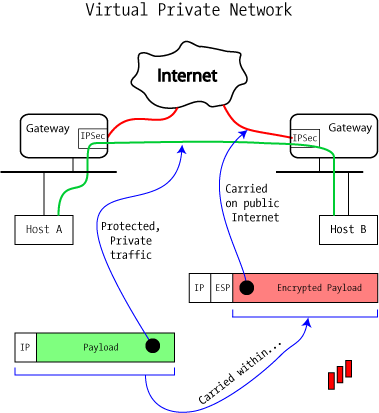Featured
Table of Contents
What Is Ipsec?
IPsec validates and encrypts data packets sent over both IPv4- and IPv6-based networks. IPsec procedure headers are found in the IP header of a package and define how the information in a package is managed, including its routing and shipment throughout a network. IPsec includes a number of elements to the IP header, consisting of security info and one or more cryptographic algorithms.

ISAKMP is defined as part of the IKE procedure and RFC 7296. It is a framework for crucial establishment, authentication and settlement of an SA for a safe exchange of packets at the IP layer. To put it simply, ISAKMP defines the security criteria for how two systems, or hosts, interact with each other.
They are as follows: The IPsec process begins when a host system acknowledges that a package requires security and should be transferred utilizing IPsec policies. Such packages are thought about "fascinating traffic" for IPsec purposes, and they trigger the security policies. For outbound packets, this means the suitable file encryption and authentication are used.
Internet Protocol Security Explained
In the 2nd step, the hosts utilize IPsec to work out the set of policies they will utilize for a secured circuit. They also verify themselves to each other and established a safe channel in between them that is utilized to negotiate the method the IPsec circuit will encrypt or verify information sent out across it.

A VPN essentially is a personal network implemented over a public network. VPNs are typically utilized in companies to allow staff members to access their business network remotely.
Generally used in between protected network entrances, IPsec tunnel mode allows hosts behind one of the entrances to communicate securely with hosts behind the other gateway. For instance, any users of systems in an enterprise branch office can firmly connect with any systems in the primary workplace if the branch workplace and primary workplace have secure gateways to function as IPsec proxies for hosts within the particular workplaces.
What Is Ipsec Encryption And How Does It Work? - Compritech
IPsec transportation mode is used in cases where one host needs to interact with another host. The two hosts work out the IPsec circuit directly with each other, and the circuit is generally torn down after the session is complete. A Protected Socket Layer (SSL) VPN is another technique to protecting a public network connection.
With an IPsec VPN, IP packets are protected as they travel to and from the IPsec gateway at the edge of a private network and remote hosts and networks. An SSL VPN protects traffic as it moves in between remote users and an SSL entrance. IPsec VPNs support all IP-based applications, while SSL VPNs only support browser-based applications, though they can support other applications with customized development.
See what is finest for your organization and where one type works best over the other.
What Is Ipsec? Internet Protocol Security And Cellular Iot
Finally, each IPsec endpoint confirms the identity of the other endpoint it desires to communicate with, ensuring that network traffic and data are only sent out to the desired and allowed endpoint. Regardless of its fantastic energy, IPsec has a few concerns worth discussing. Direct end-to-end communication (i. e., transmission approach) is not constantly available.
The adoption of numerous regional security guidelines in large-scale distributed systems or inter-domain settings might position extreme concerns for end-to-end interaction. In this example, presume that FW1 needs to examine traffic material to discover invasions which a policy is set at FW1 to deny all encrypted traffic so regarding implement its content examination requirements.
Users who utilize VPNs to from another location access a personal company network are put on the network itself, providing the very same rights and functional abilities as a user who is linking from within that network. An IPsec-based VPN may be produced in a range of methods, depending upon the needs of the user.
Guide To Ipsec Vpns - Nist Technical Series Publications
Since these components might originate from different providers, interoperability is a must. IPsec VPNs enable smooth access to enterprise network resources, and users do not always need to utilize web access (gain access to can be non-web); it is for that reason a service for applications that require to automate interaction in both methods.
Its structure can support today's cryptographic algorithms along with more effective algorithms as they end up being available in the future. IPsec is a necessary component of Web Protocol Version 6 (IPv6), which companies are actively deploying within their networks, and is strongly recommended for Web Procedure Variation 4 (IPv4) executions.
It provides a transparent end-to-end safe and secure channel for upper-layer procedures, and executions do not require adjustments to those procedures or to applications. While possessing some drawbacks connected to its intricacy, it is a mature procedure suite that supports a variety of file encryption and hashing algorithms and is highly scalable and interoperable.
How Does A Vpn Work? Advantages Of Using A Vpn
Like VPNs, there are many methods an Absolutely no Trust design can be executed, however options like Twingate make the procedure significantly simpler than having to wrangle an IPsec VPN. Contact Twingate today for more information.

IPsec isn't the most common internet security procedure you'll use today, but it still has a vital function to play in protecting web interactions. If you're utilizing IPsec today, it's probably in the context of a virtual private network, or VPN. As its name indicates, a VPN produces a network connection between 2 devices over the general public internet that's as protected (or practically as safe and secure) as a connection within a private internal network: most likely a VPN's the majority of well-known usage case is to permit remote workers to gain access to protected files behind a corporate firewall software as if they were operating in the office.
For many of this post, when we state VPN, we indicate an IPsec VPN, and over the next several sections, we'll discuss how they work. A note on: If you're aiming to set up your firewall to allow an IPsec VPN connection, be sure to open UDP port 500 and IP ports 50 and 51.
What Is Ipsec?

When this has actually all been set, the transport layer hands off the data to the network layer, which is mostly controlled by code working on the routers and other parts that comprise a network. These routers pick the route specific network packages take to their location, however the transport layer code at either end of the interaction chain does not require to understand those details.
On its own, IP doesn't have any integrated security, which, as we noted, is why IPsec was developed. Today, TLS is constructed into practically all web browsers and other internet-connected applications, and is more than enough protection for daily internet use.
That's why an IPsec VPN can include another layer of protection: it includes protecting the packets themselves. An IPsec VPN connection starts with facility of a Security Association (SA) in between 2 interacting computer systems, or hosts. In basic, this includes the exchange of cryptographic secrets that will permit the celebrations to encrypt and decrypt their communication.
Latest Posts
Top Vpn Services - Enterprise Networking Planet
What Is A Business Vpn? Understand Its Uses And ...
Best Vpns For Freelancers And Remote Workers: Protect ...